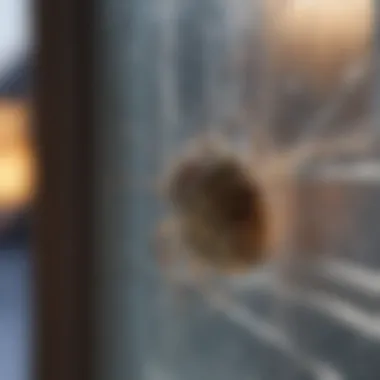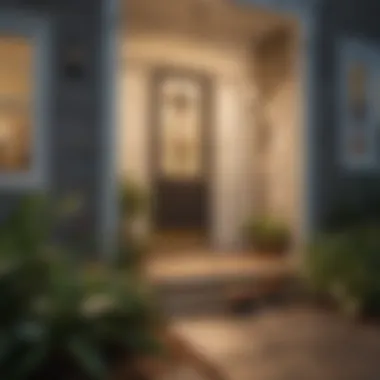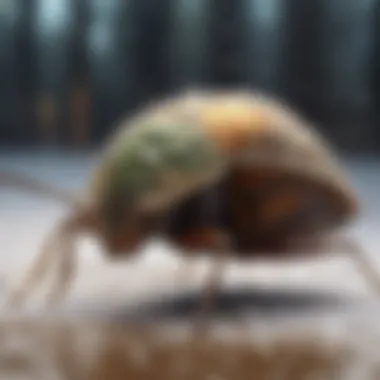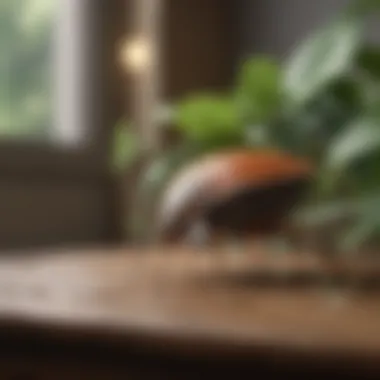Understanding Stink Bugs in Your Home During Winter


Intro
Stink bugs are a common nuisance for homeowners during the winter months. As temperatures drop, these insects seek refuge in warm places, often finding their way into homes. Understanding their behavior and entry patterns can help in effectively managing and controlling these pests. This article will explore various aspects concerning stink bugs in the house, from their seasonal habits to practical prevention methods.
Key Points to Discuss
- The behavior of stink bugs in winter.
- Common entry points into homes.
- Methods for controlling and preventing infestations.
- The implications of having stink bugs in your residence.
With this understanding, readers can take proactive steps to address the presence of stink bugs, ensuring a more comfortable living environment during the coldest months.
Intro to Stink Bugs
Stink bugs are more than just an annoyance for homeowners during the winter months. Understanding their characteristics and behaviors is essential for effective management. Recognizing their presence can help prevent infestations that complicate your indoor environment.
Notably, stink bugs are drawn to warmth and shelter, seeking refuge inside homes when temperatures drop. This migration is a crucial aspect of their survival strategy. As such, being aware of their habits can inform your approach to prevention and control.
Moreover, stink bugs can cause various inconveniences. Their scent can be overwhelming. They can also pose risks to plants if they get inside, which is pertinent for gardeners or anyone who enjoys the aesthetics of house plants. Additionally, learning about these pests establishes a foundation for later discussions on effective control measures aimed at minimizing their impact on your living space.
In summary, this section lays the groundwork for comprehending stink bugs in winter, connecting their behaviors to the implications for your home environment. Understanding stink bugs is paramount for effective management and creating a comfortable indoor atmosphere.
Nature and Habits of Stink Bugs
Stink bugs belong to the family Pentatomidae and are known for their distinctive odor when threatened. They are primarily plant feeders, with a preference for fruits and vegetables. Their feeding habits can lead to significant agricultural damage. However, when they invade homes, their focus shifts away from food.
These pests typically congregate in large groups when seeking hibernation spots. This behavior can lead to more severe infestations in some households. Interesting enough, stink bugs are also known for their ability to produce a strong chemical defense, which is a key factor contributing to their name.
During the day, stink bugs often hide in warm, sheltered locations. They tend to become more active during the evening, searching for food or better shelter. Though they are often harmless to people, their presence can still be unsettling.
Life Cycle of Stink Bugs
The life cycle of stink bugs consists of several stages: egg, nymph, and adult. They are known to reproduce in the warmer months, laying clusters of eggs on the undersides of leaves. The eggs hatch into nymphs, which go through several molts before maturing into adults.
- Egg Stage: Eggs are typically laid in clusters, with each cluster containing around 20 to 30 eggs. They are yellow to green at this stage.
- Nymph Stage: Upon hatching, nymphs are small and lack wings. They are generally considered the most vulnerable phase, being largely dependent on their environment and feeding sources.
- Adult Stage: Adults emerge after several weeks. Their maturity is marked by the development of wings and a more defined shape. This stage is when they seek shelter for winter.
Understanding their life cycle is crucial for determining when to take preventive measures. With this knowledge, you can identify when they are more likely to invade your space, enabling better control and management strategies.
The Seasonal Behavior of Stink Bugs
Understanding the seasonal behavior of stink bugs is crucial for homeowners dealing with these pests during winter. Seasonal changes greatly influence their activities, survival strategies, and likelihood of invading homes. Through this insight, effective prevention and control measures can be implemented.
Winter Survival Strategies
During winter, stink bugs adapt to survive the harsh conditions. They undergo specific behavioral and physiological changes to cope with the cold. One important strategy is their ability to seek shelter. Stink bugs often look for warm places to stay.
Types of shelters include:
- Cracks in walls
- Gaps around windows
- Openings in doors
- Attics or basements
These insects enter homes seeking refuge from the freezing temperatures outside. Once they find an appropriate space, they enter a form of dormancy that allows them to survive without food until spring. It’s important to note that stink bugs are not harmful to humans but can be an annoyance.
Temperature significantly impacts their behavior. When temperatures drop, their metabolic rate slows. This change allows them to conserve energy and endure winter months. They stay inactive but can easily be disturbed during this period, which is why they are often seen inside homes on warm days


Hibernate or Invade?
As winter approaches, stink bugs face a choice: hibernate or invade. This decision hinges on environmental conditions and population density. Most stink bugs opt for hibernation in favorable microhabitats. They seek secluded spots such as wall cavities.
Invading homes is a more aggressive tactic. Factors such as food shortages or severe weather may push them to invade. Homeowners may notice an influx of these pests unexpectedly.
Deciding between hibernation and invasion determines their fall activities. If conditions are suitable, stink bugs will hibernate. If conditions worsen or resources dwindle, they may become more intrusive. Homeowners should be vigilant, as this can lead to a significant presence in living spaces.
Why Stink Bugs Enter Homes
Understanding why stink bugs find their way into homes during winter is crucial for homeowners. Their behavior alters with the changing season. By recognizing the reasons for their intrusion, individuals can better prepare and take steps to prevent it. This knowledge not only aids in decreasing the likelihood of an invasion but also informs proper responses if they do enter.
Common Entry Points
Stink bugs are adept at finding ways into homes. Their typical entry points include:
- Cracks and gaps: These pests can exploit even the smallest openings in walls, windows, and doors. Inspecting the exterior for any visible cracks can reduce their access.
- Attic vents: Oftentimes, holes or poorly sealed vents serve as gateways for stink bugs.
- Foundation gaps: Gaps at the foundation level provide routes for pests to enter. Sealing these can be quite effective.
- Screens: Damaged or loose screens can be an overlooked entry point, especially on windows or doors.
- Utility entry points: Areas where pipes and cables enter a structure may allow their intrusion.
To minimize these entry points, homeowners should regularly maintain their properties. Sealing cracks, properly fitting screens, and covering vents appropriately can help keep stink bugs out by reducing their access points.
Attraction to Indoor Spaces
The indoor environment holds particular appeal for stink bugs during winter. There are several factors that attract them:
- Warmth: As temperatures drop, stink bugs seek warmth. Homes provide a warm refuge from the cold.
- Food Sources: If food sources like plants or fruit are available inside, stink bugs are likely to come in search of sustenance.
- Shelter: Stink bugs look for places to hide during colder months. Human dwellings, with their nooks and crannies, can be perfect for such shelter.
Understanding these factors can help individuals mitigate the risk of attracting stink bugs inside. Maintaining clean spaces and removing potential food sources can greatly decrease their chance of making a home indoors.
"Being aware of how stink bugs enter homes allows homeowners to proactively manage and reduce their infestations."
Ultimately, addressing the reasons stink bugs invade homes can drive effective prevention. By taking preventive measures, one can maintain a comfortable living environment free of these pests.
Identifying Stink Bugs in Your Home
Identifying stink bugs in your home is essential, especially during the colder months. Knowing how to recognize these pests can help prevent a small inconvenience from turning into a larger infestation. Stink bugs, particularly the brown marmorated stink bug, may infiltrate your living space seeking warmth. This awareness increases your ability to respond quickly to any presence, allowing for effective control. Furthermore, understanding how to identify stink bugs may help you distinguish them from other similar-looking insects.
Physical Characteristics
Stink bugs have distinct physical traits that make them easier to identify. They are generally brown or greenish in color, with a shield-like shape. The size of a stink bug can range from half an inch to three-quarters of an inch long. Their body is slightly wider than it is long. Here are some key characteristics:
- Shape: Shield-like, giving them a unique profile.
- Color: Usually brown or green, sometimes with dark markings.
- Legs and Antennae: Six legs and two prominent antennae are often noticeable.
A unique feature of stink bugs is their ability to exude a foul odor when threatened, which is an important part of their defense mechanism. This scent can often be a clear sign of a stink bug presence. If you detect a musty or pungent smell in your home, consider checking carefully for these insects.
Signs of Infestation
Recognizing the signs of a stink bug infestation is just as important as identification. Here are some common indicators that show you may have a problem:
- Live Bugs: Spotting live stink bugs crawling on windowsills or walls is a straightforward sign.
- Dead Bugs: Finding dead stink bugs in corners or behind furniture can also indicate an infestation.
- Eggs: Look for clusters of eggs, which can be small and metallic in appearance, usually found on plants or near windows.
Monitoring for these signs can be crucial during winter months when stink bugs seek shelter. Homeowners should remain vigilant. Regular inspections of windows, doors, and entry points will help catch any problems early on.


"Effective identification and monitoring practices can dramatically reduce the likelihood of a massive stink bug invasion within your home."
By remaining informed about the physical characteristics and signs of these pests, homeowners can take proactive measures to control and prevent infestations. Addressing any signs promptly can help maintain a comfortable living environment.
Impacts of Stink Bugs in Homes
The relevance of understanding the impacts of stink bugs on homes during winter cannot be overstated. As homeowners encounter these pests, it is crucial to recognize how their presence might affect property and health. This section will highlight two primary considerations: potential damage to property and health concerns directly related to infestations.
Potential Damage to Property
Stink bugs can cause various kinds of damage to homes. One significant issue arises from their behavior during colder months. As they seek warmth, they might infiltrate the interior of a house, gathering in tight spaces such as window frames, attics, and behind walls. The very presence of stink bugs in these areas can create discomfort for residents and may lead to increased maintenance costs as the bugs can damage insulation and electrical wires if they invade eaves and attic spaces.
"The presence of stink bugs in the home may lead to a problematic situation requiring professional pest control services."
Another concern is that when stink bugs feel threatened, they can release a foul odor. This odor not only creates an unpleasant environment but can also linger on surfaces and in fabrics. If numerous stink bugs are present, the resulting odor can become overwhelming, leading to expensive cleaning and remediation efforts. Additionally, the stains that can occur from their droppings are difficult to remove, especially from light-colored materials.
To prevent these damages, taking preventative measures is advisable. This can include proper sealing of entry points and maintaining a tidy garden to reduce outside populations near the home.
Health Concerns Related to Infestation
While stink bugs are not known as significant health threats, their presence in the home can lead to other complications. Some individuals may experience allergic reactions or respiratory issues due to the odor released by stink bugs. Though rare, these sensitivities can exacerbate existing health problems, particularly for those with allergies or asthma.
Moreover, the stress caused by an infestation can lead to mental discomfort for homeowners. Knowing that your living space is being invaded by pests can affect overall well-being, leading to anxiety and frustration.
Although stink bugs do not bite or sting, the potential discomfort they inflict can influence the quality of life for inhabitants. Maintaining a clean and controlled environment is, therefore, essential for managing both the stench and the fear of infestation.
Preventing Stink Bugs from Invading Your Home
As winter approaches, stink bugs look for warmer places to survive. Preventing these pests from invading your home is essential for maintaining comfort and cleanliness during the colder months. A few steps taken now can save you from larger problems later.
Stink bugs not only create a nuisance, but they can also pose risks in terms of potential property damage. Their waste can leave stains, and if their numbers increase, the impact of their presence can become overwhelming.
Sealing Entry Points
To begin preventing stink bugs from entering your home, it is vital to identify and seal potential entry points. Here are key considerations for sealing:
- Windows and Doors: Ensure that all windows and doors are well-fitted. Replace any damaged screens and use weather stripping to fill gaps.
- Cracks and Crevices: Inspect exterior walls for cracks. Use caulk or foam sealant to close small openings.
- Utility Lines: Check places where utility lines enter the house. Seal these entry points effectively.
Note: In most cases, stink bugs enter homes through small spaces. Taking a proactive approach in sealing these gaps can drastically reduce their numbers.
Environmental Modifications
In addition to sealing entry points, modifying your environment can deter stink bugs:
- Landscaping Choices: Consider the plants in your garden. Specific plants attract stink bugs. You may want to shift to less favorable options or create barriers with non-attractive plants.
- Lighting: Stink bugs are attracted to light. Use yellow or LED bulbs that are less inviting for these pests.
- Maintain Cleanliness: Keeping your surroundings clean is vital. Remove fallen fruits and debris, which can attract stink bugs. Regular cleaning will help in reducing the likelihood of an infestation.
Implementing these strategies does not guarantee a stink bug-free home, but they can significantly reduce the risk. Being vigilant and proactive is key to managing these invaders effectively.
Control Methods for Stink Bugs
Controlling stink bugs is essential for maintaining a comfortable living environment during winter months. These pests can quickly become a nuisance, invading homes in search of warmth and shelter. Understanding the methods available for their control allows homeowners to choose effective strategies that minimize their presence. Employing the right control methods not only reduces the irritation caused by these insects but also prevents the potential damage they may inflict.


Non-Toxic Solutions
For those who prefer to avoid chemical treatments, non-toxic solutions are available. These remedies are typically safer for both humans and pets, making them attractive options for families.
- Essential Oils: Certain essential oils, such as peppermint and lavender, can repel stink bugs. Mixing these oils with water in a spray bottle can create a natural deterrent. When sprayed at entry points, the scent can help keep pest away.
- Soap and Water: A simple mixture of soap and water can be quite effective. Spray this mixture directly on stink bugs to suffocate them. This method is immediate and can be safe when ingested in small quantities, reducing risks in households with children.
- Diatomaceous Earth: This fine powder can be sprinkled in areas where stink bugs frequent. It works by dehydrating the bugs when they come into contact with it. This method offers a long-lasting solution without resorting to harmful chemicals.
Incorporating these non-toxic options not only enhances safety but can also be cost-effective. They provide peace of mind and a measure of control that feels more natural than harsher chemical solutions.
Chemical Control Options
When non-toxic methods do not suffice, chemical control options can be considered. It is essential to utilize these products responsibly, understanding the potential impact on health and the environment.
- Insecticidal Sprays: Various insecticides are designed specifically for stink bugs. Products containing cyfluthrin or bifenthrin have shown effectiveness in killing these pests on contact. It is crucial to follow the manufacturer's instructions closely for the best results and safety.
- Residual Pesticides: These are applied to surfaces and can act as long-lasting treatments against stink bugs. When applied to potential entry points, they can prevent infestation for several weeks. Remember that these should not be used in areas frequented by pets or children without ample precautions.
- Traps: Manage stability with specific traps that attract and capture stink bugs. Some traps utilize light, while others release pheromones to draw them in. They are a handy addition to any pest control strategy when paired with other methods.
Using a combination of chemical and non-toxic solutions can create a comprehensive approach to managing stink bugs effectively. Consider your home's needs when choosing the right method.
Effective control of stink bugs combines knowledge of their habits with appropriate strategies for reduction. By exploring both non-toxic and chemical methods, homeowners can maintain a stink bug-free environment, ensuring their houses remain pleasant during the winter months.
Responding to an Infestation
Recognizing the presence of stink bugs in your home is crucial for managing any potential infestation effectively. Addressing this issue promptly will help minimize the associated problems, ensuring a comfortable living environment. Stink bugs, particularly during winter months, can become a nuisance and threaten your household well-being. Therefore, understanding how to respond when these pests infiltrate your home is of utmost importance. This section will discuss immediate actions to take and strategies for long-term management.
Steps to Take Immediately
Upon discovering stink bugs, swift action can prevent a larger infestation. Here are important steps to take:
- Locate and Identify the Bugs: Inspect areas where you commonly find these pests, such as windowsills, corners, and light fixtures. Identifying stink bugs early can limit their spread.
- Capture Them: Use a vacuum cleaner to capture stink bugs safely. This method helps remove them without causing them to release their characteristic scent. Be sure to empty the vacuum cleaner outside to avoid re-entry into your home.
- Seal Entry Points: Check for any gaps or cracks around doors, windows, and vents. Use caulk or weather stripping to seal these areas efficiently. This step prevents more stink bugs from entering.
- Reduce Indoor Attractants: Stink bugs attracted to light will often gather near bright fixtures. Turn off unnecessary lights in the evening, diminishing their attraction to your space.
Long-Term Management Strategies
Once you have addressed the immediate issue, it’s essential to adopt long-term strategies to prevent future infestations. Consider the following measures:
- Regular Inspections: Make it a habit to check for signs of stink bugs seasonally. Early detection will alleviate the need for more aggressive measures down the line.
- Maintain Landscaping: Ensure that your garden is less inviting to stink bugs. Trim overgrown plants and avoid keeping ornamental vegetation close to your home.
- Utilize Natural Predators: Encourage the presence of natural predators, such as birds or beneficial insects, that can help keep stink bug populations in check.
- Consult Professionals: If your problem persists, consider hiring pest control experts. They can provide targeted treatment options tailored to your specific situation.
"Effective management of stink bugs not only involves immediate action but also embraces proactive measures that deter future infestations."
By employing both immediate and long-term strategies, homeowners can effectively respond to an infestation while maintaining a peaceful living environment.
Closure
The conclusion of this article serves several key purposes. Understanding stink bugs during winter months is essential for homeowners who do not wish to live alongside these pests. The article integrated multiple aspects of stink bug behavior, their entry patterns, physical characteristics, impacts, and effective control methods. By highlighting the importance of prevention and response strategies, readers can anticipate threats and take proactive steps to safeguard their living spaces.
Summary of Key Points
In summary, the main points addressed in this article include:
- Nature and habits of stink bugs that confirm their adaptability to colder climates.
- Life cycle insights to show how these pests reproduce and survive.
- Common entry points to help homeowners recognize vulnerabilities in their homes.
- The signs of infestation that allow for early detection.
- The impacts stink bugs can have on property and health.
- Effective prevention techniques that involve simple modifications at entrances and openings.
- Different control methods, both non-toxic and chemical.
- Immediate steps and long-term strategies for managing infestations effectively.
Addressing these points provides a well-rounded comprehension of the situation, equipping the reader with knowledge for better home management.
Final Thoughts on Stink Bugs
"Understanding the behaviors and patterns of stink bugs is not just academic; it is a practical endeavor for improved home life."
Taking the time to assess one's home for vulnerabilities and responding swiftly to infestations can mean the difference between a peaceful winter and an overwhelming nuisance. As winter approaches, taking proactive measures is a wise choice for any homeowner.
For further information on pest management strategies and trends, you may find resources at Wikipedia or Britannica.
By comprehensively understanding and adapting to the challenges posed by stink bugs, homeowners can enjoy their spaces without unwelcome interruptions.







